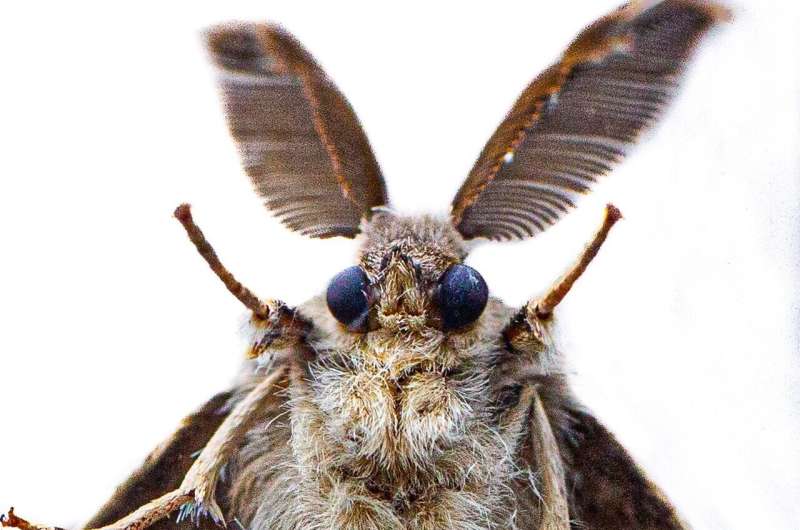This article has been reviewed according to Science X's editorial process and policies. Editors have highlighted the following attributes while ensuring the content's credibility:
fact-checked
reputable news agency
proofread
Washington trapped a big number of these invasive, tree-eating moths in 2023

The Washington State Department of Agriculture has trapped 103 invasive spongy moths this year, one of the highest counts in recent decades.
Spongy moths are an invasive species that have permanent populations in Eastern states in New England as well as Virginia, Michigan, Ohio and Minnesota.
The seemingly harmless creatures have done extensive damage due to their high reproduction rate and voracious appetite for more than 500 species of trees and plants. When the moth eats the leaves of deciduous or evergreen trees, the loss of leaves stresses the trees and makes them more susceptible to other pests and diseases that can kill them. Evergreen trees specifically have a harder time recovering and are more likely to die after being defoliated, according to the department.
The moth is not only destructive, it also reproduces at a high rate. A single cream-colored female moth with its thin antennae and brown zigzag-striped wings can lay 1,000 eggs, according to the department.
Washington state officials have largely been able to keep the spongy moth at bay by spending roughly $1 million on early detection and eradication.
Officials speculate that the high number this year is due to people resuming travel after the pandemic and inadvertently moving spongy moth egg masses from the Eastern U.S. into Washington, said department spokesperson Katherine Kersten. Since 1995, the only year with more spongy moths trapped was 2017 when 117 were caught. In 2022 and 2021, only 30 and six moths were caught respectively.
The largest spikes in detection, like in the year 1983, are likely related to big outbreaks in Eastern states, said department spokesperson Karla Salp. After a large outbreak elsewhere, Washington often sees an increase in the number of moths trapped due to people moving to Washington or visiting, she said.
Of the 103 moths found this year, 77 were trapped near Steamboat Island Road in Thurston County, making it the largest number trapped in one area in 30 years, according to the department. Moths were also found in Pierce, Skagit, King, San Juan and Snohomish counties.
Crews have since identified a spongy moth egg mass at the Thurston County site and are still determining next steps, Kersten said.
To eradicate the moths, officials often apply a naturally occurring bacteria called BTK or bacillus thuringiensis kurstaki to an area with ground crews or a helicopter or plane in the spring. After the caterpillars hatch and eat trees and shrubs coated with the substance, the bacteria activates in their stomachs, killing them, according to the department. Salp said the department can also do widespread trapping in the area.
In Eastern states, hundreds of thousands of acres every year are damaged by the moths and then quarantined and sprayed. In 2015, the moths consumed the leaves of 180,000 acres of trees in Connecticut.
Every year, the state Department of Agriculture places around 20,000 brightly colored cardboard traps throughout the state in an effort to prevent the moths from taking hold and defoliating the Evergreen State.
The traps, which are coated with a sticky substance and a synthetic mating pheromone, are checked every few weeks during "flight season" between June and September. Crews take note of how many moths are caught and then later look for egg masses in the areas with the highest concentration of catches.
The moth was called the gypsy moth until 2022, when the Entomological Society of America renamed the species, acknowledging the name as an ethnic slur referring to the Romani people.
2023 The Seattle Times. Distributed by Tribune Content Agency, LLC.



















